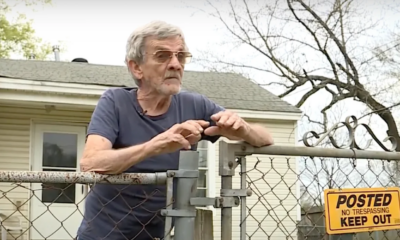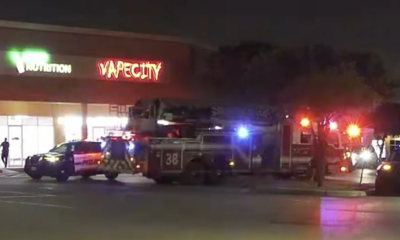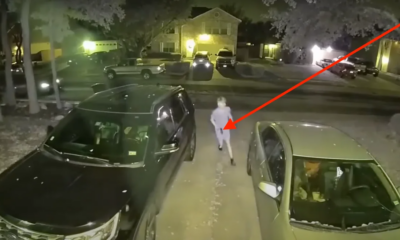Preparedness
Lawyers Seek Gag Order in High-Profile Murder Case

Attorneys representing Franklin Jose Pena Ramos, one of the suspects accused of murdering 12-year-old Jocelyn Nungaray, are requesting a protective order to mitigate negative media exposure surrounding the case.
The legal team for Pena Ramos, 26, argues that “extra-judicial statements” made to the media could lead to “undue prejudice,” potentially compromising their client’s right to a fair trial.
“The additional extra-judicial statements to the news media are likely to produce a result of undue prejudice in the community to deprive the Defendant of a fair trial guaranteed by Article I of the Texas Constitution and the Sixth and Fourteenth Amendments to the United States Constitution,” the attorneys stated in their motion.
They cited remarks made by Harris County District Attorney Kim Ogg, including her assertion that, “[M]ake no mistake, this is a horrific crime,” and her comment on the broader issue, “the immigration system is broken.”
According to the filing, Ogg had allegedly made “numerous statements about the case that went beyond the statements of the prosecutor during the probable cause hearing.”
Franklin Jose Pena Ramos and Johan Jose Martinez-Rangel, 21, were arrested in June and charged with capital murder by the Houston Police Department in connection with Nungaray’s death.
As reported by Breitbart News, Nungaray snuck out of her apartment on June 16. Surveillance footage captured her at a 7/11 convenience store shortly after midnight with Pena Ramos and Martinez-Rangel.
Law enforcement officials stated that after leaving the 7/11, the three went to a nearby bridge. Between 1:00 a.m. and 2:00 a.m., the men allegedly strangled Nungaray and left her body in a creek.
Prosecutors presented evidence in June showing that Pena Ramos and Martinez-Rangel had walked Nungaray to the bridge after leaving the store. At the bridge, Martinez-Rangel allegedly took hold of Nungaray’s neck, “got on top of her,” and covered her mouth. The men also allegedly undressed her, leaving her partially naked.
Both suspects, who are Venezuelan nationals, were apprehended at the southern border and released into the United States with a Notice to Appear (NTA).
Last Thursday, Alexis Nungaray, Jocelyn’s mother, joined former President Donald Trump at the U.S.-Mexico border in Arizona to emphasize the importance of border control.
Watch a local news report about the incident below:
Let us know what you think, please share your thoughts in the comments below.

Preparedness
Unlock Survival Secrets Beyond Stockpiling Essentials

When it comes to long-term survival, many people equate preparedness with stockpiling essentials like food and weapons. However, true preparedness encompasses a broader range of skills that go beyond merely accumulating resources. In the event of a crisis, such as an electromagnetic pulse (EMP) event, our ability to rely on traditional skills becomes crucial. These are skills our grandparents likely possessed, but many of us today have never had the opportunity to practice.
One of the fundamental skills for self-reliance is cooking from scratch. The ability to prepare meals using basic ingredients, rather than relying on pre-packaged or canned foods, is invaluable. In times of emergency, when eating out is not an option, those who can cook from scratch will have a significant advantage. As the source material notes, “learning how to cook from scratch is something you cannot afford to ignore.”
Healthcare skills are equally important. In today’s world, it seems that a trip to the doctor is the go-to solution for even minor ailments. However, previous generations knew how to manage their health without relying on doctors and pharmaceuticals for every issue. Learning how to care for yourself and your family without medical intervention can be a vital survival skill.
Growing and foraging skills are essential when store shelves are empty. Gardening and farming require more than just planting seeds; they demand knowledge and physical endurance. Additionally, knowing how to identify and safely forage wild edibles can provide a much-needed food source. As the source material suggests, “learning some of the basics of gardening and foraging now could give you a little head start.”
Sewing skills offer another layer of self-sufficiency. When shopping for clothes is no longer an option, knowing how to make or repair garments becomes crucial. Sewing, along with related skills like spinning, weaving, and knitting, not only allows for clothing repair but also provides opportunities for bartering.
Working with livestock also demands a specific set of skills. Handling animals safely and providing them with medical care can ensure they remain healthy and productive, whether for meat, dairy, or fiber. Even chickens can pose a risk if not managed properly, highlighting the importance of livestock handling skills.
For those who consume meat, hunting, trapping, and butchering skills are indispensable. Procuring meat without relying on grocery stores requires knowledge of various hunting methods and the ability to butcher animals properly to maximize the meat’s utility and safety.
Carpentry and construction skills round out the list of essential survival skills. While building an entire house may not be necessary, the ability to construct or repair simple structures, such as sheds or livestock buildings, is invaluable. These skills also extend to basic home repairs, ensuring a safe and functional living environment.
This is by no means an exhaustive list, but it serves as a starting point for evaluating and expanding your skill set. As the source material advises, “keep learning and adding to your skills bank.” Local community colleges and county extension offices often offer classes in a wide range of practical skills, from backyard chicken keeping to furniture building, often at little to no cost.
Incorporating these skills into your life not only enhances your preparedness but also enriches your ability to thrive in any situation.
Let us know what you think, please share your thoughts in the comments below.
Preparedness
Master the Art of Sheltering in Place for Emergencies

When an unforeseen emergency strikes, the directive to “shelter in place” can be a lifesaver. This involves finding a secure indoor location and remaining there until authorities provide an “all clear” or instruct you to evacuate. Such situations can arise from various threats, including active shooters, severe weather, or hazardous chemical spills.
In the event that local officials instruct you to “stay put,” it is crucial to act swiftly. Tune into local radio or television stations for specific guidance tailored to the emergency. Generally, the first step is to get indoors, bringing along your loved ones, emergency supplies, and pets if possible.
Once inside, identify a safe spot within your location. The ideal spot will vary based on the nature of the emergency. Remain in this location until officials confirm it is safe to leave.
Communication is key during these times. Reach out to your emergency contact to inform them of your situation, whereabouts, and the status of all family members. Use your phone sparingly to ensure lines remain open for emergency responders. Keep your phone accessible for reporting life-threatening situations.
Stay informed by continuously listening to updates via radio, television, or phone. Do not exit your shelter until authorities declare it safe. Should evacuation become necessary, adhere to the instructions provided.
In certain emergencies, such as chemical leaks, it is vital to prevent outside air from entering your space. If officials advise you to “seal the room,” take the following actions: turn off air-moving devices like fans and air conditioners, gather your family and supplies inside, and block any air entry points. Await further instructions from officials.
Once the danger has passed, ventilate your space by turning on fans and other air circulation devices. Everyone should step outside until the building’s air has exchanged with fresh outdoor air.
Preparation is essential for effective sheltering in place, particularly during a chemical attack or leak. Select a room in your home with minimal windows and doors, such as a master bedroom with an adjoining bathroom. For chemical events, choose a room on a higher floor to avoid sinking vapors, unlike other scenarios where lower levels are safer.
Avoid using vehicles as shelters unless absolutely necessary, as they are not airtight enough for chemical protection. If you find yourself needing to shelter in place at home, stock your designated room with essentials such as a flashlight, battery-powered radio, extra batteries, bottled water, and non-perishable food. If bottled water is unavailable, toilet tank water is a viable alternative, but avoid tap water.
To seal the room, pre-cut plastic sheeting to fit windows and doors, securing it with duct tape to create an airtight seal. Cover vents and electrical outlets as well.
If caught in an emergency while driving, and you cannot reach a safe indoor location, pull over to the side of the road, stop the engine, and stay put until it is safe to proceed. Seek shade if it is warm to prevent overheating. Keep your radio on for updates, as modern car radios consume minimal battery power.
Even after receiving clearance to resume travel, continue listening to the radio and follow law enforcement instructions. For a comprehensive guide to preparedness, FEMA offers a free PDF booklet that serves as an excellent resource for starting your journey towards being prepared.
Let us know what you think, please share your thoughts in the comments below.
Preparedness
Homesteaders’ Secret Weapon for Success and Survival

Homesteading is often synonymous with self-reliance, but even the most independent homesteaders need a supportive network. While the dream of living off the land is appealing, the reality can be isolating. It’s crucial to recognize that no one can handle every challenge alone. A strong community is invaluable for both daily support and in times of crisis.
A homesteading community offers a wealth of knowledge and experience. When questions arise, having a group of knowledgeable peers to consult can be a game-changer. Beyond practical advice, these connections provide companionship, easing feelings of loneliness and isolation.
In times of need, a community can be a lifeline. Whether it’s bartering goods, lending a hand with a difficult task, or offering support during a disaster, having a network to rely on is essential. “If you experience a disaster, those closest to you will help you pick up the pieces.”
Building a community doesn’t happen by accident; it requires intentional effort. As adults, forming new bonds can be more challenging than it was on the playground. However, with purposeful actions, these connections can flourish.
Begin by getting to know your neighbors, even if they aren’t fellow homesteaders. They can be your first point of contact in emergencies and may become unexpected allies. Shopping locally is another excellent way to forge relationships. Frequent visits to local farms and markets allow you to meet and support small business owners.
Seek out like-minded individuals by attending events such as gardening classes at the library or visiting the farmers’ market. Online platforms like Meetup and Facebook also offer groups where you can connect with local homesteaders. “Find Like-Minded Individuals: Be intentional about seeking out fellow homesteaders.”
Don’t hesitate to ask for help when needed. People appreciate being needed, and reaching out can open doors to new friendships. Sharing meals is another powerful way to build community bonds. Inviting neighbors or fellow homesteaders for dinner or a potluck can quickly turn acquaintances into friends.
To strengthen these connections, contribute what you can to the community. Whether it’s sharing excess produce, offering skills like knitting, or helping with a neighbor’s big task, every contribution counts. “Find Something to Contribute: Do you have an abundance of fresh produce? Do you have honey from beekeeping?”
Finally, don’t forget to have fun together. Organizing activities like outdoor picnics or games can transform casual relationships into supportive networks. “If you want to move from casual acquaintances to people you can turn to in a crisis, find ways to have fun together.”
If you’re wondering where to find these like-minded individuals, consider visiting local farmers’ markets, libraries, or farm supply stores. Livestock auctions and community-supported agriculture (CSA) groups are also excellent places to meet fellow homesteaders.
By intentionally building and nurturing a community, homesteaders can enjoy the benefits of shared knowledge, support, and friendship, making the journey of self-sufficiency a little less solitary.
Let us know what you think, please share your thoughts in the comments below.
-

 Tactical1 year ago
Tactical1 year ago70-Year-Old Fends Off Intruder with Lead-Powered Message
-

 Tactical1 year ago
Tactical1 year agoVape Shop Employee Confronts Armed Crooks, Sends Them Running
-

 Preparedness11 months ago
Preparedness11 months agoEx-Ballerina’s Guilty Verdict Sends Tremors Through Gun-Owner Community
-

 Preparedness9 months ago
Preparedness9 months agoGood Samaritan Saves Trooper in Harrowing Interstate Confrontation
-

 Tactical1 year ago
Tactical1 year agoMidnight SUV Theft Interrupted by Armed Homeowner’s Retaliation
-

 Survival Stories2 years ago
Survival Stories2 years agoEmily’s 30-Day Experience of Being Stranded on a Desert Island
-

 Preparedness10 months ago
Preparedness10 months agoArizona Engineer’s Headless Body Found in Desert: Friend Charged
-

 Preparedness9 months ago
Preparedness9 months agoBoy Saves Dad from Bear Attack with One Perfect Shot
Don
September 6, 2024 at 12:42 pm
Put these animals to death.
Ann
September 6, 2024 at 1:14 pm
Criminals seem to get more rights and protection than the public who they commit criminal acts against.
PPuck64
September 6, 2024 at 3:11 pm
He SHOULD be gagged–just before the firing squad.
Paul
September 6, 2024 at 5:27 pm
Give no quarter to these evil criminals! Death is the only way to deal with them!
Don
September 7, 2024 at 12:31 pm
True. The animals need true justice which saves the money to keep the savages.
Don
September 7, 2024 at 12:29 pm
A gag order is needed for the lawyers first and then the media who blow things out of proportion to influence verdicts.
Ray
September 9, 2024 at 12:47 pm
This all comes down to the democratic and soros there the ones who let them in